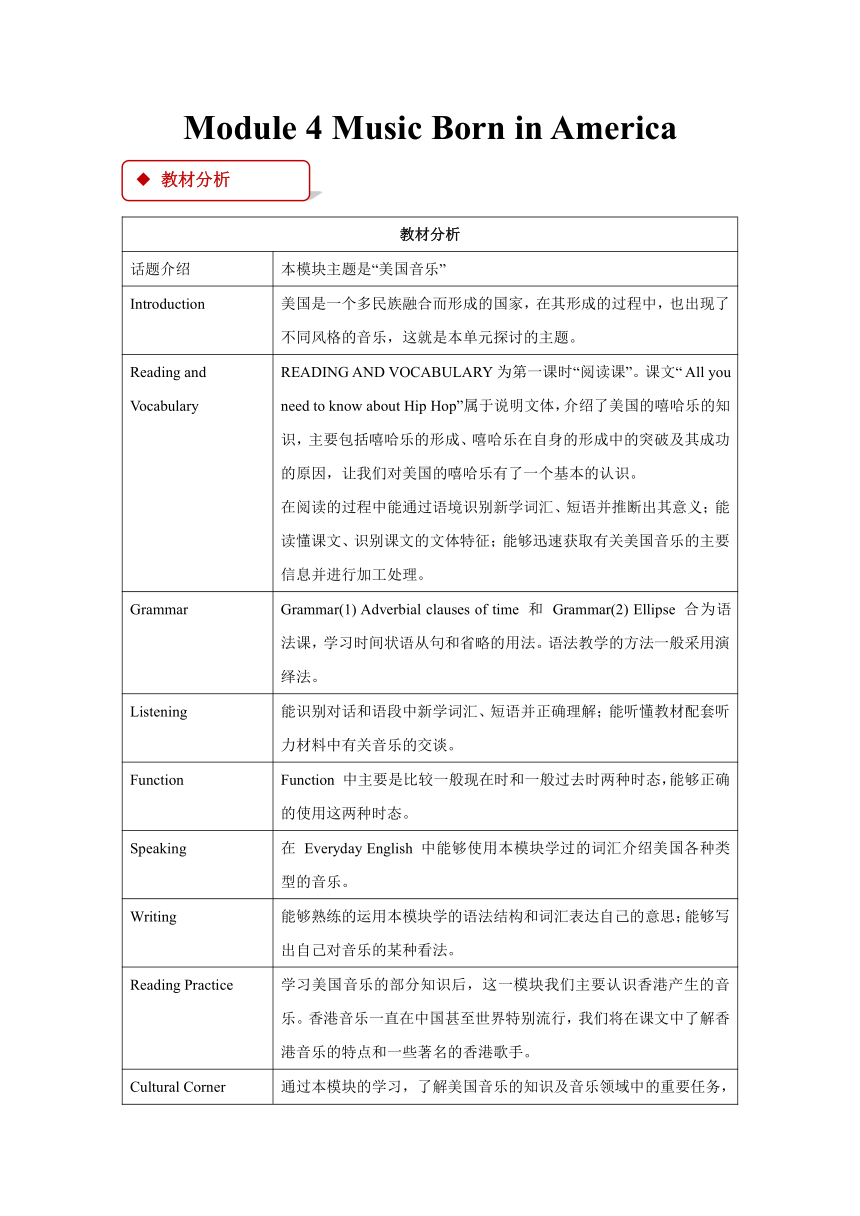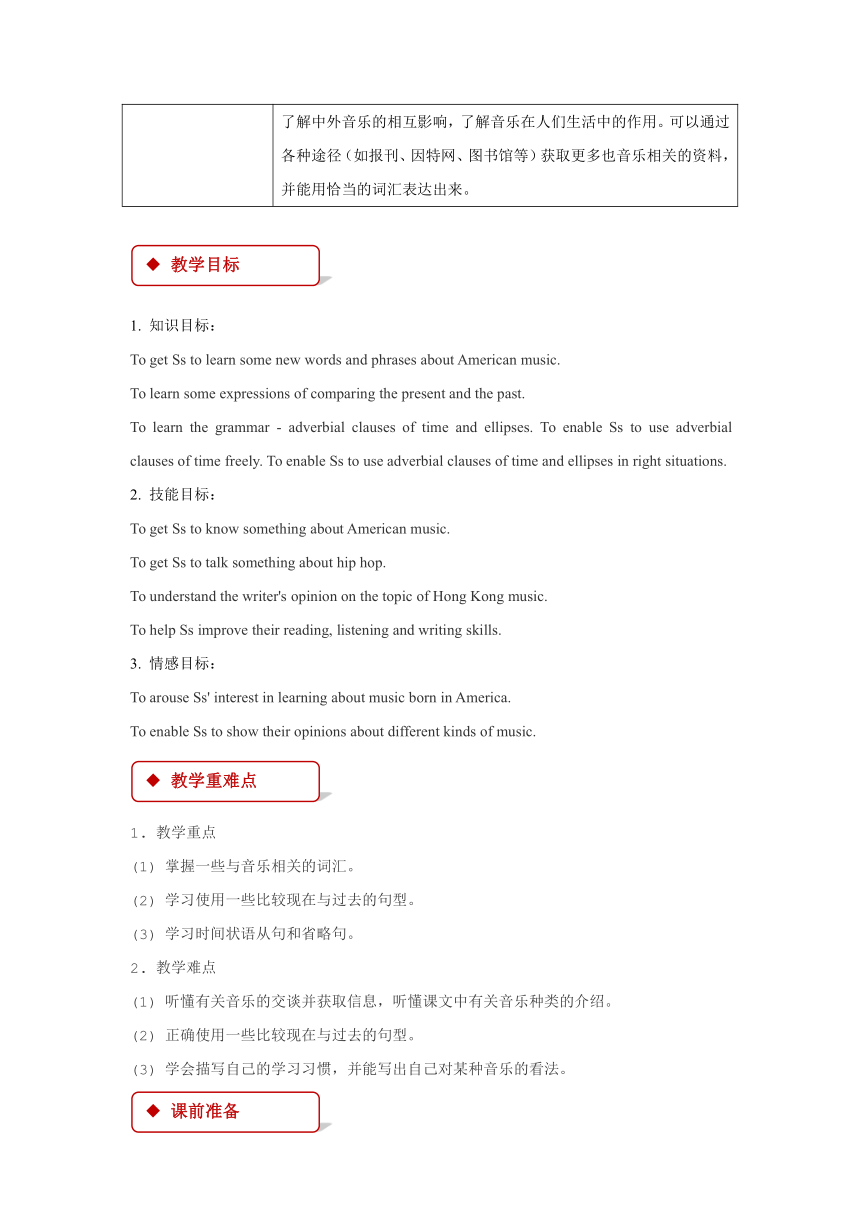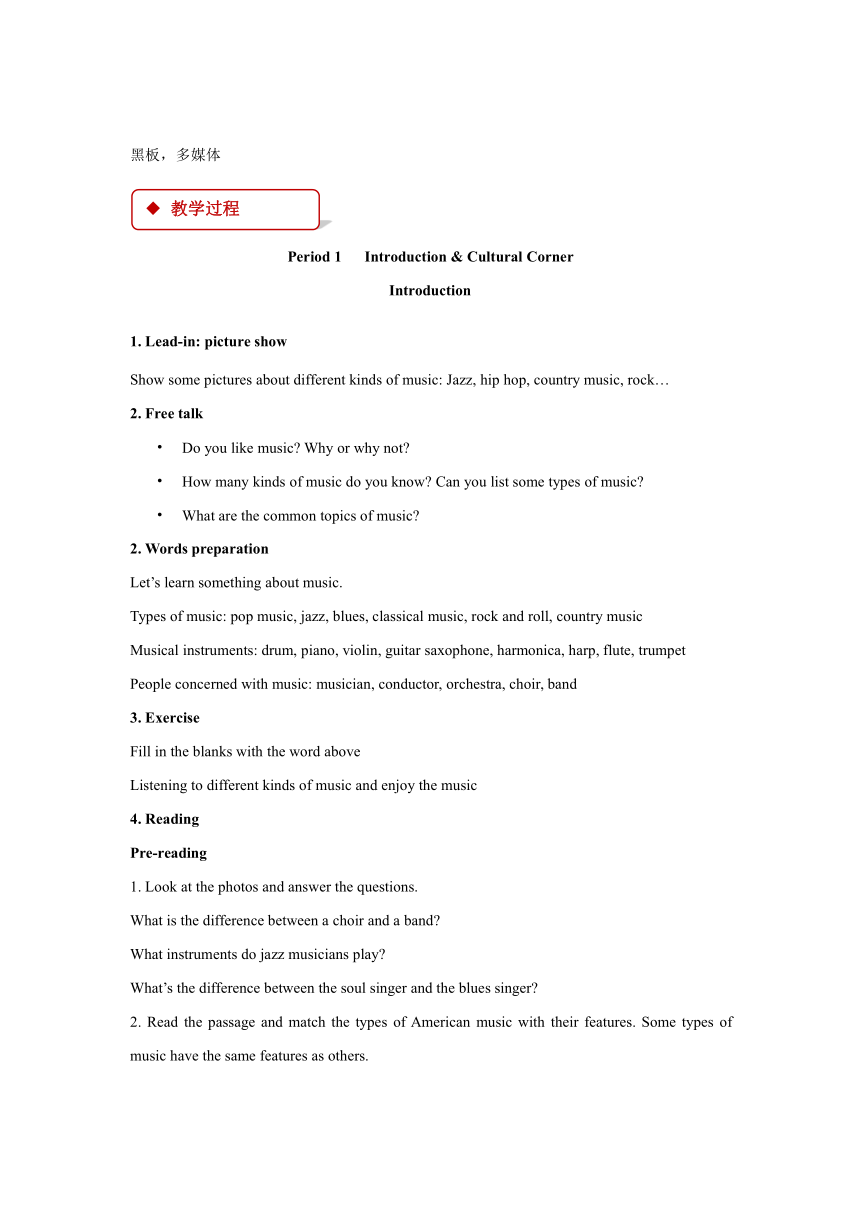选修7 Module 4 Music Born in America 模块教案
文档属性
| 名称 | 选修7 Module 4 Music Born in America 模块教案 |

|
|
| 格式 | zip | ||
| 文件大小 | 123.8KB | ||
| 资源类型 | 教案 | ||
| 版本资源 | 外研版 | ||
| 科目 | 英语 | ||
| 更新时间 | 2019-07-31 21:11:16 | ||
图片预览




文档简介
Module 4 Music Born in America
教材分析
话题介绍
本模块主题是“美国音乐”
Introduction
美国是一个多民族融合而形成的国家,在其形成的过程中,也出现了不同风格的音乐,这就是本单元探讨的主题。
Reading and Vocabulary
READING AND VOCABULARY为第一课时“阅读课”。课文“ All you need to know about Hip Hop”属于说明文体,介绍了美国的嘻哈乐的知识,主要包括嘻哈乐的形成、嘻哈乐在自身的形成中的突破及其成功的原因,让我们对美国的嘻哈乐有了一个基本的认识。
在阅读的过程中能通过语境识别新学词汇、短语并推断出其意义;能读懂课文、识别课文的文体特征;能够迅速获取有关美国音乐的主要信息并进行加工处理。
Grammar
Grammar(1) Adverbial clauses of time 和 Grammar(2) Ellipse 合为语法课,学习时间状语从句和省略的用法。语法教学的方法一般采用演绎法。
Listening
能识别对话和语段中新学词汇、短语并正确理解;能听懂教材配套听力材料中有关音乐的交谈。
Function
Function 中主要是比较一般现在时和一般过去时两种时态,能够正确的使用这两种时态。
Speaking
在 Everyday English 中能够使用本模块学过的词汇介绍美国各种类型的音乐。
Writing
能够熟练的运用本模块学的语法结构和词汇表达自己的意思;能够写出自己对音乐的某种看法。
Reading Practice
学习美国音乐的部分知识后,这一模块我们主要认识香港产生的音乐。香港音乐一直在中国甚至世界特别流行,我们将在课文中了解香港音乐的特点和一些著名的香港歌手。
Cultural Corner
通过本模块的学习,了解美国音乐的知识及音乐领域中的重要任务,了解中外音乐的相互影响,了解音乐在人们生活中的作用。可以通过各种途径(如报刊、因特网、图书馆等)获取更多也音乐相关的资料,并能用恰当的词汇表达出来。
1. 知识目标:
To get Ss to learn some new words and phrases about American music.
To learn some expressions of comparing the present and the past.
To learn the grammar - adverbial clauses of time and ellipses. To enable Ss to use adverbial clauses of time freely. To enable Ss to use adverbial clauses of time and ellipses in right situations.
2. 技能目标:
To get Ss to know something about American music.
To get Ss to talk something about hip hop.
To understand the writer's opinion on the topic of Hong Kong music.
To help Ss improve their reading, listening and writing skills.
3. 情感目标:
To arouse Ss' interest in learning about music born in America.
To enable Ss to show their opinions about different kinds of music.
1. 教学重点
(1) 掌握一些与音乐相关的词汇。
(2) 学习使用一些比较现在与过去的句型。
(3) 学习时间状语从句和省略句。
2. 教学难点
(1) 听懂有关音乐的交谈并获取信息,听懂课文中有关音乐种类的介绍。
(2) 正确使用一些比较现在与过去的句型。
(3) 学会描写自己的学习习惯,并能写出自己对某种音乐的看法。
黑板,多媒体
Period 1 Introduction & Cultural Corner
Introduction
1. Lead-in: picture show
Show some pictures about different kinds of music: Jazz, hip hop, country music, rock…
2. Free talk
Do you like music? Why or why not?
How many kinds of music do you know? Can you list some types of music?
What are the common topics of music?
2. Words preparation
Let’s learn something about music.
Types of music: pop music, jazz, blues, classical music, rock and roll, country music
Musical instruments: drum, piano, violin, guitar saxophone, harmonica, harp, flute, trumpet
People concerned with music: musician, conductor, orchestra, choir, band
3. Exercise
Fill in the blanks with the word above
Listening to different kinds of music and enjoy the music
4. Reading
Pre-reading
1. Look at the photos and answer the questions.
What is the difference between a choir and a band?
What instruments do jazz musicians play?
What’s the difference between the soul singer and the blues singer?
2. Read the passage and match the types of American music with their features. Some types of music have the same features as others.
Post reading
1. Match after reading
2. True or False
In Gospel music, instruments are more important than voices.
Soul music is a mixture of blues, gospel and a little rock and roll.
Jazz was developed by Latin-American musicians.
The words of early blues songs often consisted of a single line repeated two or three times before changing.
3. Discussion
What is your favorite kind of music?
When do you listen to it?
Do you think music can help you study?
Cultural Corner
1. Read and answer
What kind of music was each artist famous for?
What else do you know about other musicians
2. Language points
Short for, short of, manage to, make an impression on,
4. Homework
Read and recite the passage.
Review music vocabulary.
Preview “All You Need to Know about Hip and Hop”.
Period 2 Reading and vocabulary
1. Warm- up
Show pictures about hip hop, craffiti art, breakdance, rap artists, DJ
2. Discuss
Work in pairs. Look at some words about music from the passage. Do you know what they mean?
3. Fast-reading
Read the four parts, and get the main idea of each part and answer the questions.
What is hip hop and how did it start?
What was the big breakthrough?
Why was hip hop so successful?
How did rap singers record their songs?
3. Deep – reading
Read part 1 and find the words of the meaning followed. ( see PPT )
Read part 3 and 4, match the words and phrases with the correct meaning. ( see PPT )
Complete the sentences with the correct words in the box.
4. Group work.
What did you know about hip hop before you read the article on Page 44 and 45?
Do you know the names of any rap artists?
Have you ever seen a rap artist or a breakdancer? If you have, what were your impressions?
What are your opinions about rap music and hip hop?
5. Listen to the song
Rocky Mountain High
Homework
Revise the reading text and vocabulary.
Finish Tasks 5-6 in workbook, Module 4.
Preview the grammar points.
Period 3 Listening & Function
Listening
1. Warm- up
Work in groups. Match the instructions on the left with the meanings on the right.
2. Listening
Choose the correct answers.
Eg. 1. Who are the people?
a. Two sisters.
b. A mother and a daughter.
c. Two friends.
3. Exercise
Work in pairs. Read this extract from the conversation and underline the stressed words.
Function
1. Comparing the present and the past
2. Answer the questions.
Which words and expressions tell you that she is making comparisons?
Which words tell you that she is talking about things that happened regularly in the past?
3. Complete these sentences, making similar comparisons between the present and the past.
Eg. Modern pop stars earn more money than pop stars used to in the sixties.
Speaking
1. Discussion 1
What have you learnt in this module?
Work in groups and talk about the things you learnt in detail.
2. Discussion 2
Discuss the questions about modern music.
What kind of music is there on Chinese radio and TV?
Is there more modern or traditional music on radio and TV?
What type of modern music do you like?
3. Enjoy a song Music Is Power.
4. Homwork
1. Revise the listening text and Function.
2. Finish Everyday English on Page 51.
3. Finish tasks 7-10 in workbook Module 4.
Period 4 Reading and writing & Reading practice
Reading and writing
1. Warm-up
Show the video about Opera Turandot
Ask student: Do you think classical music helps you study?
2. Reading
Read the passage and answer the questions.
What is probably the best type of music to listen to while you are studying?
2. What effect did listening to music before a test have on some students?
3. Does music have the same effect on all students?
3. Writing
Write a description of your study habits. Use these questions to help you.
Do you agree with the writer that listening to music helps you study?
Does music make you fall asleep or concentrate?
Do you prefer studying in a quiet or noisy environment?
What type of music is best for studying?
Is there any type of music you cannot listen to while you are studying?
What will your parents think if they hear music coming from your bedroom when you are supposed to be studying?
Do you think your test scores will improve if you listen to Mozart when you revise?
Reading practice
1. Pre-reading
Answer the questions before reading.
What do you know about Cantopop (香港音乐)?
Who are the stars?
Do you think they are known outside China?
What else do the singers do?
2. While-reading
Read the passage and choose the sentence which best expresses its main idea.
3. After-reading
Read the passage and talk about the writer’s opinion.
Read the passage and find the best meaning of the phrases and sentences.
Eg. swap information share information
Complete the sentences in your own words.
Eg. Music born in Hong Kong is booming because it is becoming popular throughout the world
4. Discussion and writing
Talk about your favourite pop stars. Why do you like them and their music? Are they well known outside China?
Write a passage to describe your favourite pop star.
6. Homework
1. Revise the whole module.
2. Finish your writing task above.
3. Finish Tasks in workbook, Module 4.
Period 5 Grammar
Adverbial Clause
1. Grammar Introduction
Adverbial Clause 状语从句
2. 例句介绍
3. 例题解析
Ellipsis
1. Grammar Introduction
Ellipsis 状语从句
2. Example sentences例句介绍
3. Sample analysis 例题解析
略。
教材分析
话题介绍
本模块主题是“美国音乐”
Introduction
美国是一个多民族融合而形成的国家,在其形成的过程中,也出现了不同风格的音乐,这就是本单元探讨的主题。
Reading and Vocabulary
READING AND VOCABULARY为第一课时“阅读课”。课文“ All you need to know about Hip Hop”属于说明文体,介绍了美国的嘻哈乐的知识,主要包括嘻哈乐的形成、嘻哈乐在自身的形成中的突破及其成功的原因,让我们对美国的嘻哈乐有了一个基本的认识。
在阅读的过程中能通过语境识别新学词汇、短语并推断出其意义;能读懂课文、识别课文的文体特征;能够迅速获取有关美国音乐的主要信息并进行加工处理。
Grammar
Grammar(1) Adverbial clauses of time 和 Grammar(2) Ellipse 合为语法课,学习时间状语从句和省略的用法。语法教学的方法一般采用演绎法。
Listening
能识别对话和语段中新学词汇、短语并正确理解;能听懂教材配套听力材料中有关音乐的交谈。
Function
Function 中主要是比较一般现在时和一般过去时两种时态,能够正确的使用这两种时态。
Speaking
在 Everyday English 中能够使用本模块学过的词汇介绍美国各种类型的音乐。
Writing
能够熟练的运用本模块学的语法结构和词汇表达自己的意思;能够写出自己对音乐的某种看法。
Reading Practice
学习美国音乐的部分知识后,这一模块我们主要认识香港产生的音乐。香港音乐一直在中国甚至世界特别流行,我们将在课文中了解香港音乐的特点和一些著名的香港歌手。
Cultural Corner
通过本模块的学习,了解美国音乐的知识及音乐领域中的重要任务,了解中外音乐的相互影响,了解音乐在人们生活中的作用。可以通过各种途径(如报刊、因特网、图书馆等)获取更多也音乐相关的资料,并能用恰当的词汇表达出来。
1. 知识目标:
To get Ss to learn some new words and phrases about American music.
To learn some expressions of comparing the present and the past.
To learn the grammar - adverbial clauses of time and ellipses. To enable Ss to use adverbial clauses of time freely. To enable Ss to use adverbial clauses of time and ellipses in right situations.
2. 技能目标:
To get Ss to know something about American music.
To get Ss to talk something about hip hop.
To understand the writer's opinion on the topic of Hong Kong music.
To help Ss improve their reading, listening and writing skills.
3. 情感目标:
To arouse Ss' interest in learning about music born in America.
To enable Ss to show their opinions about different kinds of music.
1. 教学重点
(1) 掌握一些与音乐相关的词汇。
(2) 学习使用一些比较现在与过去的句型。
(3) 学习时间状语从句和省略句。
2. 教学难点
(1) 听懂有关音乐的交谈并获取信息,听懂课文中有关音乐种类的介绍。
(2) 正确使用一些比较现在与过去的句型。
(3) 学会描写自己的学习习惯,并能写出自己对某种音乐的看法。
黑板,多媒体
Period 1 Introduction & Cultural Corner
Introduction
1. Lead-in: picture show
Show some pictures about different kinds of music: Jazz, hip hop, country music, rock…
2. Free talk
Do you like music? Why or why not?
How many kinds of music do you know? Can you list some types of music?
What are the common topics of music?
2. Words preparation
Let’s learn something about music.
Types of music: pop music, jazz, blues, classical music, rock and roll, country music
Musical instruments: drum, piano, violin, guitar saxophone, harmonica, harp, flute, trumpet
People concerned with music: musician, conductor, orchestra, choir, band
3. Exercise
Fill in the blanks with the word above
Listening to different kinds of music and enjoy the music
4. Reading
Pre-reading
1. Look at the photos and answer the questions.
What is the difference between a choir and a band?
What instruments do jazz musicians play?
What’s the difference between the soul singer and the blues singer?
2. Read the passage and match the types of American music with their features. Some types of music have the same features as others.
Post reading
1. Match after reading
2. True or False
In Gospel music, instruments are more important than voices.
Soul music is a mixture of blues, gospel and a little rock and roll.
Jazz was developed by Latin-American musicians.
The words of early blues songs often consisted of a single line repeated two or three times before changing.
3. Discussion
What is your favorite kind of music?
When do you listen to it?
Do you think music can help you study?
Cultural Corner
1. Read and answer
What kind of music was each artist famous for?
What else do you know about other musicians
2. Language points
Short for, short of, manage to, make an impression on,
4. Homework
Read and recite the passage.
Review music vocabulary.
Preview “All You Need to Know about Hip and Hop”.
Period 2 Reading and vocabulary
1. Warm- up
Show pictures about hip hop, craffiti art, breakdance, rap artists, DJ
2. Discuss
Work in pairs. Look at some words about music from the passage. Do you know what they mean?
3. Fast-reading
Read the four parts, and get the main idea of each part and answer the questions.
What is hip hop and how did it start?
What was the big breakthrough?
Why was hip hop so successful?
How did rap singers record their songs?
3. Deep – reading
Read part 1 and find the words of the meaning followed. ( see PPT )
Read part 3 and 4, match the words and phrases with the correct meaning. ( see PPT )
Complete the sentences with the correct words in the box.
4. Group work.
What did you know about hip hop before you read the article on Page 44 and 45?
Do you know the names of any rap artists?
Have you ever seen a rap artist or a breakdancer? If you have, what were your impressions?
What are your opinions about rap music and hip hop?
5. Listen to the song
Rocky Mountain High
Homework
Revise the reading text and vocabulary.
Finish Tasks 5-6 in workbook, Module 4.
Preview the grammar points.
Period 3 Listening & Function
Listening
1. Warm- up
Work in groups. Match the instructions on the left with the meanings on the right.
2. Listening
Choose the correct answers.
Eg. 1. Who are the people?
a. Two sisters.
b. A mother and a daughter.
c. Two friends.
3. Exercise
Work in pairs. Read this extract from the conversation and underline the stressed words.
Function
1. Comparing the present and the past
2. Answer the questions.
Which words and expressions tell you that she is making comparisons?
Which words tell you that she is talking about things that happened regularly in the past?
3. Complete these sentences, making similar comparisons between the present and the past.
Eg. Modern pop stars earn more money than pop stars used to in the sixties.
Speaking
1. Discussion 1
What have you learnt in this module?
Work in groups and talk about the things you learnt in detail.
2. Discussion 2
Discuss the questions about modern music.
What kind of music is there on Chinese radio and TV?
Is there more modern or traditional music on radio and TV?
What type of modern music do you like?
3. Enjoy a song Music Is Power.
4. Homwork
1. Revise the listening text and Function.
2. Finish Everyday English on Page 51.
3. Finish tasks 7-10 in workbook Module 4.
Period 4 Reading and writing & Reading practice
Reading and writing
1. Warm-up
Show the video about Opera Turandot
Ask student: Do you think classical music helps you study?
2. Reading
Read the passage and answer the questions.
What is probably the best type of music to listen to while you are studying?
2. What effect did listening to music before a test have on some students?
3. Does music have the same effect on all students?
3. Writing
Write a description of your study habits. Use these questions to help you.
Do you agree with the writer that listening to music helps you study?
Does music make you fall asleep or concentrate?
Do you prefer studying in a quiet or noisy environment?
What type of music is best for studying?
Is there any type of music you cannot listen to while you are studying?
What will your parents think if they hear music coming from your bedroom when you are supposed to be studying?
Do you think your test scores will improve if you listen to Mozart when you revise?
Reading practice
1. Pre-reading
Answer the questions before reading.
What do you know about Cantopop (香港音乐)?
Who are the stars?
Do you think they are known outside China?
What else do the singers do?
2. While-reading
Read the passage and choose the sentence which best expresses its main idea.
3. After-reading
Read the passage and talk about the writer’s opinion.
Read the passage and find the best meaning of the phrases and sentences.
Eg. swap information share information
Complete the sentences in your own words.
Eg. Music born in Hong Kong is booming because it is becoming popular throughout the world
4. Discussion and writing
Talk about your favourite pop stars. Why do you like them and their music? Are they well known outside China?
Write a passage to describe your favourite pop star.
6. Homework
1. Revise the whole module.
2. Finish your writing task above.
3. Finish Tasks in workbook, Module 4.
Period 5 Grammar
Adverbial Clause
1. Grammar Introduction
Adverbial Clause 状语从句
2. 例句介绍
3. 例题解析
Ellipsis
1. Grammar Introduction
Ellipsis 状语从句
2. Example sentences例句介绍
3. Sample analysis 例题解析
略。
